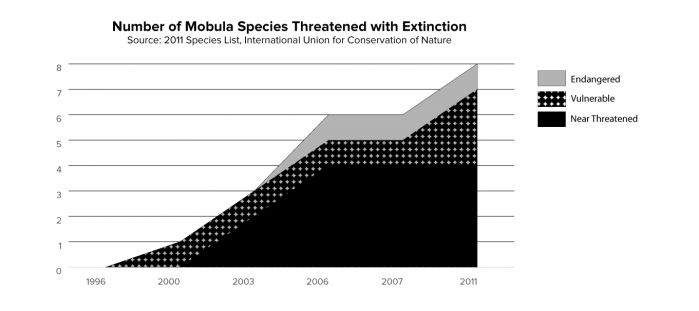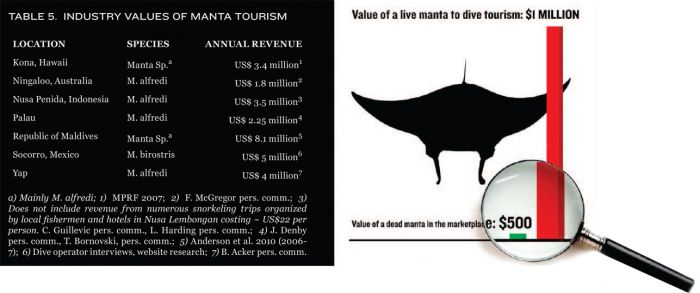Sharks Savers' Manta Ray of Hope program uses outreach campaigns to educate the public on the impact of the gill raker trade on vulnerable manta and mobula rays. Manta and mobula rays have been little studied and current regional population numbers are largely unknown. Even many questions remain unanswered regarding their biology and behaviour. We work to change that.
We do know that fisherman in Sri Lanka1, Indonesia2 and India3 as well as dive operators in Thailand4 have all recorded declines in manta and mobula ray sightings. Southern Mozambique has seen a 80% decline in manta catches5, and after heavy fishing from the 1960s to the 1990s, the Phillipines reported a 50% decline in manta ray landings6. After intense fishing in the 1980s, M.birostris has all but disappeared in the Sea of Cortez7.

A female manta may not be ready to mate until 15 years of age8, give birth to one pup on average every 2-3 years over an estimated lifespan of 40 years or more9, therefore producing only a handful of pups in her lifetime10. If she avoids fisheries and other threats and survives to her maximum age, she may give birth to a maximum of 10- 16 pups over her lifetime. In contrast, even the Great White Shark, which is afforded protections under the Convention on International Trade in Endangered Species (CITES) and also considered vulnerable, gives birth to an average of 7-14 pups every two to three years.
Mantas and mobulas are often found feeding at the surface, making them easy to capture by net or harpoon11. Compounding the problem, local populations tend to aggregate in predictable coastal areas to feed and visit cleaning stations, making them vulnerable to local fisheries12. Small island groups of mantas are particularly vulnerable because they may have genetically indepedent stocks that could be depleted quickly with little chance of recovery13. Those species that migrate across open ocean on the other hand, must contend with multiple fisheries as both targets and bycatch14.
Manta and mobula rays are highly intelligent and social animals that have a broad appeal to divers and snorkelers. They are frequently the #1 attraction to divers and are consistently ranked in the top three of marine life that divers most often ask to see. Shark Savers works with local governments to promote responsible dive ecotourism as a viable alternative to harvesting by producing reports and providing data on the potentially large and sustainable financial benefits to coastal communities … if manta and mobulas are kept alive.

Some poor fishing communities in India, the Philippines and Indonesia have shifted from hunting whale sharks to developing successful eco-tourism industries, changes that have revitalized these communities while also protecting these iconic animals. The same opportunities exist for community-based tourism development centered on manta and mobula rays.
1 - Fernando, D. and Stevens, G. 2011 A study of Sri Lanka’s manta and mobula ray
2 - Setiasih, N. 2011. Indonesia Fishery Investigation. Manta Ray of Hope, 15 pp.
3 - Couturier, L.I.E., Marshall, A.D., Jaine, F.R.A., Kashiwagi, T., Pierce, S.J., Townsend, K.A., Weeks, S.J., Bennett, M.B., and Richardson, A.J. In Press. The Biology and Ecology of the Mobulidae. In: Journal of Fish Biology.
4 - R. Parker pers. comm., R. Dion pers. comm.
5 - Marshall, A. D. 2009. Biology and population ecology of Manta birostris in southern Mozambique. PhD Thesis, University of Queensland
6 - Alava, E.R.Z., Dolumbaló, E.R., Yaptinchay, A.A., and Trono, R.B. 2002. Fishery and trade of whale sharks and manta rays in the Bohol Sea, Philippines. In: Fowler, S.L., Reed, T.M., Dipper, F.A. (eds) Elasmobranch Biodiversity, Conservation and Management: Proceedings of the International Seminar and Workshop. Sabah, Malaysia, July 1997, pp 132–148
7 - Homma, K., Maruyama, T., Itoh, T., Ishihara, H., and Uchida, S. 1999. Biology of the manta ray, Manta birostris Walbaum, in the Indo-Pacific. In: Seret, B. and Sire, J.Y. (eds) Indo-Pacific fish biology: Proc 5th Int Conf Indo-Pacific Fishes, Noumea, 1997. Ichthyological Society of France, Paris, p 209–216
8 - Marshall, A., Kashiwagi, T., Bennett, M.B., Deakos, M., Stevens, G., McGregor, F., Clark, T., Ishihara, H. & Sato, K. 2011. Manta alfredi. In: IUCN 2011. IUCN Red List of Threatened Species. Version 2011.2. <www.iucnredlist.org>.
9 - Marshall, A., Bennett, M.B., Kodja, G., Hinojosa-Alvarez, S., Galvan-Magana, F., Harding, M., Stevens, G. & Kashiwagi, T. 2011. Manta birostris. In: IUCN 2011. IUCN Red List of Threatened Species. Version 2011.2. <www.iucnredlist.org>.
10 - Stevens, J.D., Bonfil, R., Dulvy, N.K. and Walker, P.A. 2000. The effects of fishing on sharks, rays and chimaeras (chondrichthyans), and the implications for marine ecosystems. ICES Journal of Marine Science, 57: 476-494.
11 - Dewar, H. (2002). Preliminary report: Manta harvest in Lamakera. p. 3 p. Oceanside, USA: Report from the Pfleger Institue of Environmental Research and the Nature Conservancy.
12 - Dewar, H., Mous, P., Domeier, M., Muljadi, A., Pet, J., and Whitty, J. 2008. Movements and site fidelity of the giant manta ray, Manta birostris, in the Komodo Marine Park, Indonesia. Marine Biology, 155(2): 121-133.
13 - Deakos, M., Baker, J., and Bejder, L. 2011. Characteristics of a manta ray (Manta alfredi) population off Maui, Hawaii, and implications for management. Marine Ecology Progress Series, 429: 245-260.
14 - Stevens, J.D., Bonfil, R., Dulvy, N.K. and Walker, P.A. 2000. The effects of fishing on sharks, rays and chimaeras (chondrichthyans), and the implications for marine ecosystems. ICES Journal of Marine Science, 57: 476-494.